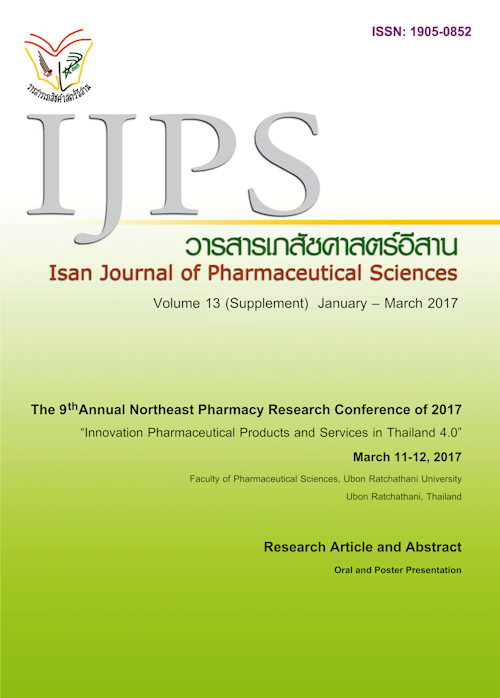Determination of lead in candies from Khon Kaen province and Vientiane capital by atomic absorption spectrophotometry
Main Article Content
Abstract
Introduction: Lead content was determined in 40 different brands of candy samples available in local market of Khon Kaen province, Thailand, and Vientiane capital, Lao PDR. All samples were selected on the basis of their colorful appearances. The regulation 1881/2006 of the 2006 European Union Council and the announcement of The Ministry of Public Health of Thailand, 98/BE 2529 (1986), were recommended that the safety level for lead contamination should not be higher than 0.2 and 1.0 mg kg-1, respectively. Methods: The candy samples were digested with heat blockassisted acid digestion. Samples were weighted to approximately 5 g into a vessel, to which nitric acid were added. After digestion 2-3 hrs, colorless solution was obtained by using centrifuge technique at 4,000 rpm for 3 minutes. The concentration of lead (Pb) in supernatant was determined by using atomic absorption spectrophotometer at the wavelength of 283.31 nm. These samples were analyzed in triplicate. Results: For the determination of lead from 40 candy samples, it was found that the lead levels was showed the range of 0.00 M 0.21 and 0.11 M 1.12 μg g-1 for candy samples which were collected from Khon Kaen province and Vientiane capital, respectively. The average of lead level was 0.07 ± 0.07 and 0.39 ± 0.30 μg g-1 for candy samples from Khon Kaen province and Vientiane capital, respectively. Conclusion: Determination of lead level in 40 candy samples was examined. It was found that 11 and 20 candy samples, collected from Khon Kaen province and Vientiane capital, respectively, contaminated with lead.
Article Details
In the case that some parts are used by others The author must Confirm that obtaining permission to use some of the original authors. And must attach evidence That the permission has been included
References
Acar O, Kılıç Z, Türker AR. Determination of lead in cookies by electrothermal atomic absorption spectrometry with various chemical modifiers. Food Chemistry. 2000; 71: 117-122.
Altunay N, Gürkan R, Orhan U. A preconcentration method for indirect determination of acrylamide from chips, crackers and cereal-based baby foods using flame atomic absorption spectrometry. Talanta. 2016; 161: 143-150.
Announcement of The Ministry of Public Health, Thailand, 98/BE 2529 (1986).
Dahiya S, Karpe R, Hegde AG, Sharma RM. Lead, cadmium and nickel in chocolates and candies from suburban areas of Mumbai, India. J of Food Comp Anal. 2005; 18: 517-522.
DeJesus RM, Junior MMS, Matos GD, DosSantos AMP, Ferreira SLC. Validation of a digestion system using a digester block/cold finger system for the determination of lead in vegetable foods by electrothermal atomic absorption spectrometry. J AOAC Int. 2011; 94: 942-946.
Iwegbu CMA, Bassey FI, Tesi GO, Overah LC, Onyeloni SO, Martincigh BS. Concentrations and health risk assessment of metals in chewing gums, peppermints and sweets in Nigeria. Food Measure. 2015; 9: 160-174.
Kim KC, Park YB, Lee MJ, Kim JB, Huh JW, Kim DH, Lee JB, Kim JC. Levels of heavy metals in candy packages and candies likely to be consumed by small children. Food Res Internat. 2008; 41: 411-418.
Martínez RH, Blasco IN. Estimation of dietary intake and content of lead and cadmium in infant cereals marketed in Spain. Food Control. 2012; 26: 6-14.
Ruengsitagoon W, Anorat R, Pearruksa P. Determination of lead, arsenic, cadmium, copper and zinc in traditional medicines by atomic absorption spectrophotometry. KKU Res J. 2005; 10: 135-140.
Ruengsitagoon W, Aromdee C. Determination of lead, copper, zinc and iron in Centella asiatica by atomic absorption spectrophotometry. KKU Res J. 2009; 14: 412-420.
Zuo P, Yin BC, Ye BC. DNAzyme-based Micro- array for highly sensitive determination of metal ions. Biosens Bioelectron. 2009: 25: 935-939.


